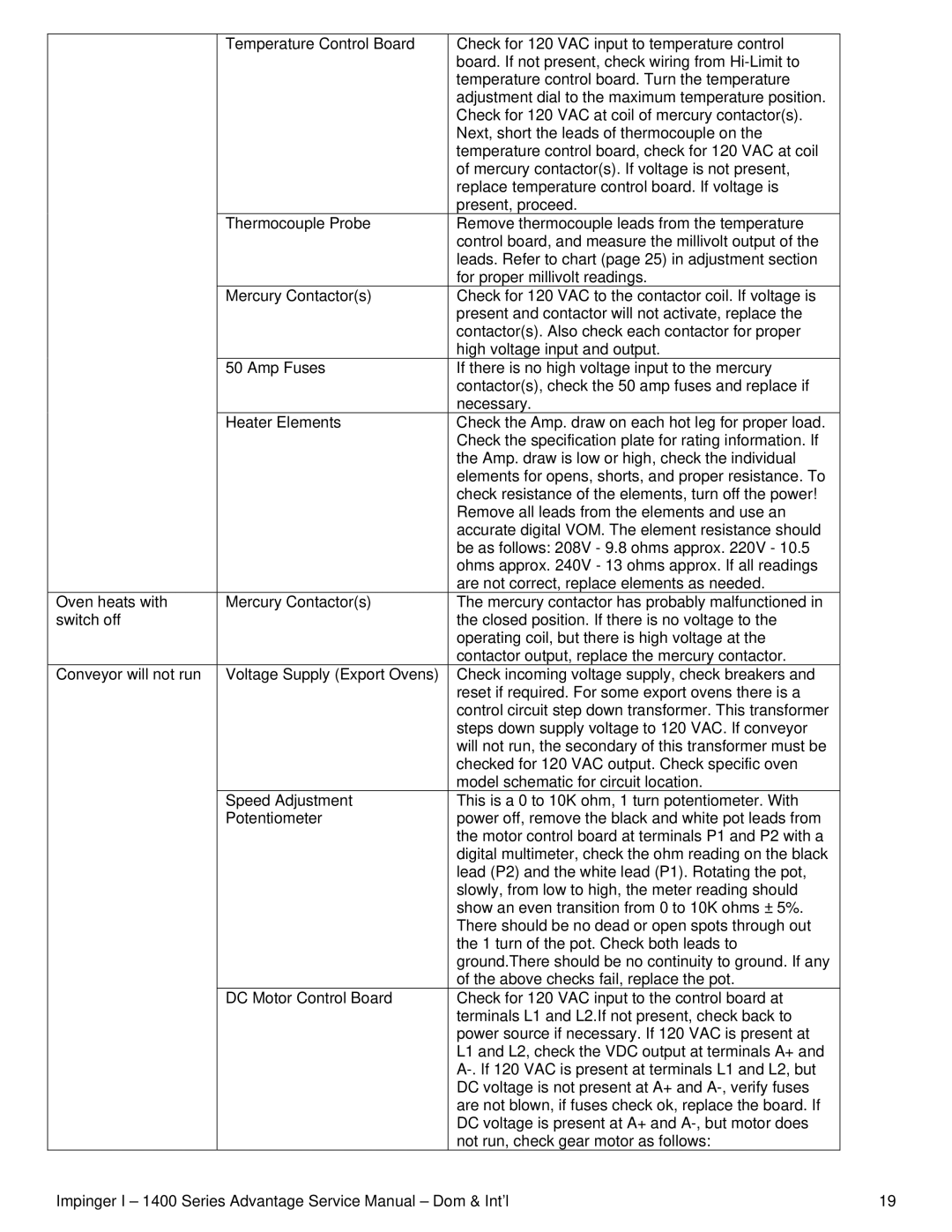| Temperature Control Board | Check for 120 VAC input to temperature control |
|
| board. If not present, check wiring from |
|
| temperature control board. Turn the temperature |
|
| adjustment dial to the maximum temperature position. |
|
| Check for 120 VAC at coil of mercury contactor(s). |
|
| Next, short the leads of thermocouple on the |
|
| temperature control board, check for 120 VAC at coil |
|
| of mercury contactor(s). If voltage is not present, |
|
| replace temperature control board. If voltage is |
|
| present, proceed. |
| Thermocouple Probe | Remove thermocouple leads from the temperature |
|
| control board, and measure the millivolt output of the |
|
| leads. Refer to chart (page 25) in adjustment section |
|
| for proper millivolt readings. |
| Mercury Contactor(s) | Check for 120 VAC to the contactor coil. If voltage is |
|
| present and contactor will not activate, replace the |
|
| contactor(s). Also check each contactor for proper |
|
| high voltage input and output. |
| 50 Amp Fuses | If there is no high voltage input to the mercury |
|
| contactor(s), check the 50 amp fuses and replace if |
|
| necessary. |
| Heater Elements | Check the Amp. draw on each hot leg for proper load. |
|
| Check the specification plate for rating information. If |
|
| the Amp. draw is low or high, check the individual |
|
| elements for opens, shorts, and proper resistance. To |
|
| check resistance of the elements, turn off the power! |
|
| Remove all leads from the elements and use an |
|
| accurate digital VOM. The element resistance should |
|
| be as follows: 208V - 9.8 ohms approx. 220V - 10.5 |
|
| ohms approx. 240V - 13 ohms approx. If all readings |
|
| are not correct, replace elements as needed. |
Oven heats with | Mercury Contactor(s) | The mercury contactor has probably malfunctioned in |
switch off |
| the closed position. If there is no voltage to the |
|
| operating coil, but there is high voltage at the |
|
| contactor output, replace the mercury contactor. |
Conveyor will not run | Voltage Supply (Export Ovens) | Check incoming voltage supply, check breakers and |
|
| reset if required. For some export ovens there is a |
|
| control circuit step down transformer. This transformer |
|
| steps down supply voltage to 120 VAC. If conveyor |
|
| will not run, the secondary of this transformer must be |
|
| checked for 120 VAC output. Check specific oven |
|
| model schematic for circuit location. |
| Speed Adjustment | This is a 0 to 10K ohm, 1 turn potentiometer. With |
| Potentiometer | power off, remove the black and white pot leads from |
|
| the motor control board at terminals P1 and P2 with a |
|
| digital multimeter, check the ohm reading on the black |
|
| lead (P2) and the white lead (P1). Rotating the pot, |
|
| slowly, from low to high, the meter reading should |
|
| show an even transition from 0 to 10K ohms ± 5%. |
|
| There should be no dead or open spots through out |
|
| the 1 turn of the pot. Check both leads to |
|
| ground.There should be no continuity to ground. If any |
|
| of the above checks fail, replace the pot. |
| DC Motor Control Board | Check for 120 VAC input to the control board at |
|
| terminals L1 and L2.If not present, check back to |
|
| power source if necessary. If 120 VAC is present at |
|
| L1 and L2, check the VDC output at terminals A+ and |
|
| |
|
| DC voltage is not present at A+ and |
|
| are not blown, if fuses check ok, replace the board. If |
|
| DC voltage is present at A+ and |
|
| not run, check gear motor as follows: |
Impinger I – 1400 Series Advantage Service Manual – Dom & Int’l | 19 |
